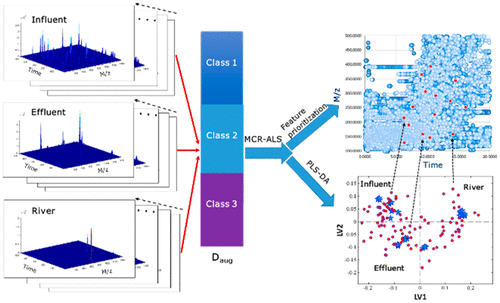当前位置:
X-MOL 学术
›
Anal. Chem.
›
论文详情
Our official English website, www.x-mol.net, welcomes your feedback! (Note: you will need to create a separate account there.)
Implementation of Chemometric Tools To Improve Data Mining and Prioritization in LC-HRMS for Nontarget Screening of Organic Micropollutants in Complex Water Matrixes.
Analytical Chemistry ( IF 6.7 ) Pub Date : 2019-06-19 00:00:00 , DOI: 10.1021/acs.analchem.9b01984 Lotta L Hohrenk 1 , Maryam Vosough 2 , Torsten C Schmidt 1, 3
Analytical Chemistry ( IF 6.7 ) Pub Date : 2019-06-19 00:00:00 , DOI: 10.1021/acs.analchem.9b01984 Lotta L Hohrenk 1 , Maryam Vosough 2 , Torsten C Schmidt 1, 3
Affiliation

|
One of the most critical steps in nontarget screening of organic micropollutants (OMP) in complex environmental samples is handling of massive data obtained from liquid chromatography coupled with high-resolution mass spectrometry (LC-HRMS). Multivariate chemometric methods have brought about great progress in processing big data obtained from high-dimensional chromatographic systems. This work aimed at a comprehensive evaluation of two LC-Q-Orbitrap mass spectrometry full-scan data sets for target and nontarget screening of OMPs in drinking and wastewater samples, respectively. For each data set, following segmentation in the chromatographic dimension, at first multivariate curve resolution alternating least-squares (MCR-ALS) was employed for simultaneous resolution of global matrices. The chromatographic peaks and the corresponding mass spectra of OMP were fully resolved in the presence of highly co-eluting irrelevant and interfering peaks. Then partial least-squares-discriminant analysis was conducted to investigate the behavior of MCR-ALS components in different water classes and selection of most relevant components. Further prioritization of features in wastewater before and after ozonation and their reduction to 24 micropollutants were then obtained by univariate statistics. Two-way information retrieved from MCR-ALS of LC-MS1 data was also used to choose common precursor ions between recovered and measured data through data-dependent acquisition. MS1 and MS2 spectral features were used for tentative identification of prioritized OMPs. This study indicates that the described strategy can be used as a promising tool to facilitate both feature selection through a reliable classification and interference-free identification of micropollutants in nontargeted and class-wise environmental studies.
中文翻译:

实施化学计量工具以改善LC-HRMS中的数据挖掘和优先级,以非目标筛选复杂水基质中的有机微量污染物。
非目标筛选复杂环境样品中的有机微量污染物(OMP)的最关键步骤之一是处理从液相色谱与高分辨率质谱(LC-HRMS)结合获得的大量数据。多元化学计量学方法在处理从高维色谱系统获得的大数据方面已取得了巨大进展。这项工作旨在全面评估两个LC-Q-Orbitrap质谱全扫描数据集,分别对饮用水和废水样品中的OMP进行目标和非目标筛查。对于每个数据集,在色谱维上进行分割之后,首先采用多变量曲线分辨率交替最小二乘(MCR-ALS)来同时解析全局矩阵。在高度共洗脱的无关峰和干扰峰的存在下,OMP的色谱峰和相应的质谱图得到了完全解析。然后进行了部分最小二乘判别分析,以研究MCR-ALS组分在不同水类别中的行为以及最相关的组分的选择。然后通过单变量统计获得臭氧处理之前和之后的废水特征的进一步优先级,并将其减少为24种微污染物。从LC-MS的MCR-ALS检索双向信息 然后通过单变量统计获得臭氧处理之前和之后的废水特征的进一步优先级,并将其减少为24种微污染物。从LC-MS的MCR-ALS检索到的双向信息 然后通过单变量统计获得臭氧处理之前和之后的废水特征的进一步优先级,并将其减少为24种微污染物。从LC-MS的MCR-ALS检索双向信息通过数据相关的采集,还使用1个数据在恢复的数据和测量的数据之间选择常见的母离子。使用MS 1和MS 2光谱特征初步确定优先OMP。这项研究表明,所描述的策略可作为一种有前途的工具,通过在非目标环境和逐级环境研究中通过可靠的分类和无干扰地识别微污染物来促进特征选择。
更新日期:2019-06-19
中文翻译:

实施化学计量工具以改善LC-HRMS中的数据挖掘和优先级,以非目标筛选复杂水基质中的有机微量污染物。
非目标筛选复杂环境样品中的有机微量污染物(OMP)的最关键步骤之一是处理从液相色谱与高分辨率质谱(LC-HRMS)结合获得的大量数据。多元化学计量学方法在处理从高维色谱系统获得的大数据方面已取得了巨大进展。这项工作旨在全面评估两个LC-Q-Orbitrap质谱全扫描数据集,分别对饮用水和废水样品中的OMP进行目标和非目标筛查。对于每个数据集,在色谱维上进行分割之后,首先采用多变量曲线分辨率交替最小二乘(MCR-ALS)来同时解析全局矩阵。在高度共洗脱的无关峰和干扰峰的存在下,OMP的色谱峰和相应的质谱图得到了完全解析。然后进行了部分最小二乘判别分析,以研究MCR-ALS组分在不同水类别中的行为以及最相关的组分的选择。然后通过单变量统计获得臭氧处理之前和之后的废水特征的进一步优先级,并将其减少为24种微污染物。从LC-MS的MCR-ALS检索双向信息 然后通过单变量统计获得臭氧处理之前和之后的废水特征的进一步优先级,并将其减少为24种微污染物。从LC-MS的MCR-ALS检索到的双向信息 然后通过单变量统计获得臭氧处理之前和之后的废水特征的进一步优先级,并将其减少为24种微污染物。从LC-MS的MCR-ALS检索双向信息通过数据相关的采集,还使用1个数据在恢复的数据和测量的数据之间选择常见的母离子。使用MS 1和MS 2光谱特征初步确定优先OMP。这项研究表明,所描述的策略可作为一种有前途的工具,通过在非目标环境和逐级环境研究中通过可靠的分类和无干扰地识别微污染物来促进特征选择。







































 京公网安备 11010802027423号
京公网安备 11010802027423号